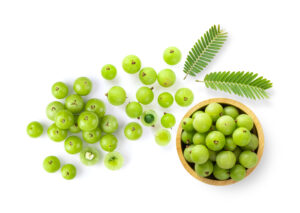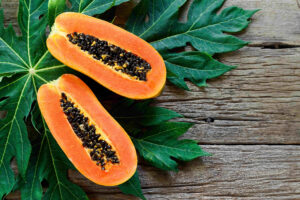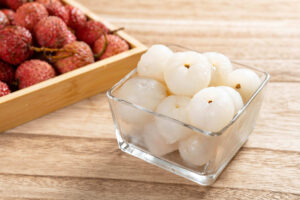Vitamin C is one of the most essential nutrients for overall well-being, playing a crucial role in many body functions. It is vital for producing collagen, L-carnitine, and neurotransmitters—key compounds that support wound healing, skin, joints, and connective tissues.
Vitamin C also works as a powerful antioxidant, protecting cells from damage caused by free radicals and even helping to regenerate other antioxidants like vitamin E.
Another important role of vitamin C is supporting the immune system and improving the absorption of non-heme iron, the type of iron found in plant-based foods.
A deficiency leads to scurvy, which causes fatigue, weak connective tissues, fragile blood vessels, slow wound healing, and easy bruising, highlighting its importance for overall health.
Many people associate vitamin C with oranges, but there are plenty of other delicious fruits and vegetables that provide even more of this essential nutrient.
In this blog, we’ll explore some of the best sources of vitamin C, their health benefits, and how to incorporate them into your diet.
How Much Do You Need?
The recommended dietary allowance (RDA) for vitamin C varies based on age, gender, and health conditions. According to the National Institutes of Health (NIH), most adults (19+) need 90 mg daily, while lactating women require 30 mg more.
Additionally, smokers need 35 mg more vitamin C compared to non smokers. The tolerable upper intake level (UL), the highest daily amount unlikely to cause side effects, is 2,000 mg.
Foods High in Vitamin C
Below are some of the best foods that are packed with vitamin C.
1. Kakadu Plum
The Kakadu plum holds the crown as the richest natural source of vitamin C.
According to studies, 100 grams of fresh kakadu plum contains 2300–3150 mg of vitamin C, with an average of 2,725 mg.
Just a 15-gram serving of kakadu plums provide an average of 409 mg of vitamin C—a staggering 453% of the Daily Value (DV).
This small green fruit, native to Australia, is also packed with antioxidants that protect against inflammation, oxidative stress and has antidiabetic properties, making it a true superfood.
Since fresh Kakadu plums are rare, their powdered form is a popular supplement in smoothies and wellness products.
2. Acerola Cherry
Acerola cherries are one of the most potent sources of vitamin C, with just a half cup (49 grams) delivering 825 mg, covering an incredible 916% of the Daily Value.
These tart cherries also contain polyphenols and carotenoids that contribute to overall health, particularly by enhancing immune function and reducing inflammation.
Due to their delicate nature, they’re often found in powders and supplements.
3. Camu-Camu
Camu-camu is another fruit with highest vitamin C content. 100 grams of camo-camo provides 1882–2280 mg vitamin C, with an average of 2081 mg.
Even a small 5-gram serving of camu-camu powder provides around 600 mg of vitamin C, which is whopping 667% of the DV.
This tangy fruit is also an excellent source of minerals like copper and manganese, along with powerful antioxidants such as flavonoids, phenolic acids, and tannins.
This Amazonian superfruit is rarely eaten fresh due to its sour taste but is widely used in powdered form, making it a powerful addition to smoothies and supplements.
Remember, vitamin C in camu-camu powder varies by brand, so it’s best to check the label to ensure it meets your daily needs.
4. Rose Hips
Rose hips, the fruit of the wild rose plant, are among the richest natural sources of vitamin C.
100 grams of rose hips provide provide 426 mg of vitamin C, which meets an impressive 473% of the DV.
Even a small amount can significantly boost immunity, collagen production, and skin health. Unlike citrus fruits, rose hips also contain antioxidants like flavonoids, carotenoids, and polyphenols, enhancing their health benefits.
However, it’s essential to remember that not all species of rose hips are edible. The fruit of the Rosa canina (dog rose) and Rosa rugosa are among the safest and most commonly consumed.
5. Amla (Indian Gooseberry)
Amla has been prized in Ayurvedic medicine for its impressive nutrient profile.
This Indian fruit offers around 334-453 mg of vitamin C per 100 grams, depending on its variety.
Just one medium-sized amla (around 30 grams) packs around 118 mg of vitamin C—an impressive 131% of the DV, far surpassing many common fruits.
This sour berry is also packed with polyphenols, flavonoids, phenolic acids, tannins, and carotenoids. These compounds contribute to anti-inflammatory, anticancer, neuroprotective, and free radical scavenging properties, making amla a powerful superfood.
Often consumed in juice form or as dried fruit, amla is a powerful addition to any diet.
6. Guava
Guava is a tropical fruit, which offers a substantial amount of vitamin C.
One medium guava (55 grams) contains 126 mg of vitamin C, which is 140% of the required daily intake, making it an excellent choice for boosting immunity and skin health.
Unlike citrus fruits, guava also offers fiber, antioxidants, and potassium, enhancing its overall health benefits. Guava stands out as a potent source of lycopene, a carotenoid responsible for its red colour.
Its high vitamin C content helps protect cells, promotes collagen production, and improves iron absorption from plant-based foods.
7. Bell Pepper
Bell peppers are a powerhouse of vitamin C, but their color determines just how much they deliver.
Red bell peppers lead the pack, offering 142 mg of vitamin C per 100 grams, covering over 158% of the DV—more than double what oranges provide!
Yellow bell peppers follow closely, packing around 154% of the DV per 100 grams, while the same serving of green bell peppers contain nearly 100 mg, which is 110% of the daily needs of vitamin C.
As bell peppers ripen from green to yellow to red, both their vitamin C and carotenoid content increase, making the sweeter, fully ripened varieties the best choice for a nutritional boost.
Whether raw or cooked, they’re a crisp and colorful way to support immunity and skin health!
8. Kiwi
Kiwi is a vitamin C superstar, offering about 93 mg per 100 grams, which is over 100% of the DV. That’s more than what oranges provide!
This vibrant green fruit not only boosts immunity but also supports collagen production for healthy skin.
Gold kiwis pack an even bigger punch, delivering around 161 mg, which is 179% of the DV of vitamin C.
They are also a good source of minerals like copper, potassium and vitamins such as folate, vitamin E. And green kiwi contains nearly seven times more vitamin K than the gold variety. Vitamin C and K, both has a crucial role in supporting bone health.
With their sweet-tart flavor and juicy texture, kiwis are a delicious way to add a powerful antioxidant boost to your diet.
9. Broccoli
Broccoli is a cruciferous vegetable packed with vitamin C.
A half cup (78 grams) of cooked broccoli contains about 51 mg of vitamin C, which equates to 57% of the DV.
This cruciferous vegetable is also loaded with vitamin K, fiber, and sulforaphane, a compound known for its cancer-fighting properties. Lightly steaming broccoli helps preserve its vitamin C content while improving digestibility.
Explore the other foods with cancer-fighting properties here!
10. Brussels Sprouts
Brussels sprouts are another cruciferous vegetable that contributes a significant amount of vitamin C to the diet.
A half cup (78 grams) offers around 48 mg of vitamin C, which makes up 53% of the daily requirement.
Alongside vitamin C, they’re rich in fiber, folate, and vitamins A, K, and B5. Roasting them enhances their natural sweetness while retaining most of their nutrients.
11. Papaya
Papaya is a tropical fruit that is packed with vitamin C. One small papaya (157 grams) provides around 95 mg of vitamin C, which yields 106% of the recommended intake.
Papaya is also rich in magnesium, folate, vitamin A and antioxidants like beta-carotene and lycopene. Additionally, it contains papain, an enzyme that aids digestion and reduces bloating.
Enjoy it fresh, blended into smoothies, or added to fruit salads for a refreshing and nutrient-rich boost.
12. Strawberries
Strawberries pack around 87 mg of vitamin C per cup (144 grams), covering 97% of the Daily Value.
Their bright red color comes from anthocyanins, powerful antioxidants that promote heart health and reduce inflammation.
As a low-calorie, fiber-rich fruit, strawberries make for a nutritious and refreshing snack.
13. Pineapple
Pineapple is a refreshing tropical fruit loaded with vitamin C. A single cup (165 grams) of pineapple chunks provides about 79 mg, covering 88% of the recommended daily value of vitamin C.
This antioxidant-rich fruit supports immune function, collagen production, and skin health, while also offering bromelain, an enzyme known for its anti-inflammatory properties.
Pineapple’s sweet-tangy taste makes it a delicious addition to both sweet and savory dishes.
14. Mango
Mango, the king of fruits, is a delicious source of vitamin C. One cup (165 grams) of mango pieces supply around 60 mg of vitamin C, which meets 67% of the recommended intake.
This tropical fruit not only supports immune function and collagen production but also delivers beta-carotene, which converts to vitamin A for healthy skin and vision.
Enjoy it fresh, in smoothies, or as a tropical salad addition!
15. Chili Peppers
Chili peppers offer an extreme vitamin C boost, with just one green chilli pepper (45 grams) packing 109 mg, which is 121% of the DV.
While bell peppers gain more vitamin C as they ripen, the opposite happens in chili peppers. A red chili pepper of the same size contains about 65 mg, covering 72% of the daily recommended value.
They also contain capsaicin, the compound responsible for their spiciness, which has been linked to metabolism-boosting and pain-relieving properties.
16. Cabbage
Cabbage, particularly the raw variety, delivers 36.6 mg of vitamin C per 100 grams, which equals 41% of the Daily Value. Both green and red cabbage are excellent sources, but red cabbage packs 1.5 times as much vitamin C.
Cooked cabbage contains more vitamin C per serving than raw cabbage due to water loss during cooking.
As cabbage softens and shrinks, its nutrients become more concentrated by weight. However, cooking—especially boiling—can still cause vitamin C loss, as it is heat-sensitive and water-soluble. To preserve the most vitamin C, opt for steaming or stir-frying instead of boiling.
Whether eaten raw in slaws or fermented as sauerkraut or kimchi, cabbage retains much of its vitamin C while also providing beneficial probiotics.
Eating cruciferous vegetables, including cabbage, raw or lightly steamed not only preserves their vitamin C but also helps retain sulforaphane.
Sulforaphane is a glucosinolate known for its anti-inflammatory properties. Click here to explore more foods that reduce inflammation!
17. Lychees
Lychees are a delicious tropical fruit packed with vitamin C, with a single fruit providing about 6.9 mg. This means a serving of 15 lychees (¾ cup) can provide more than the daily requirement of vitamin C, making them a tasty and nutritious way to stay healthy.
This juicy fruit boosts immunity, promotes skin health, and fights oxidative stress with its rich antioxidant profile.
Enjoy them fresh, in fruit salads, or blended into smoothies for a burst of flavor and nutrients!
18. Citrus Fruits
Citrus fruits are among the best natural sources of vitamin C, delivering a powerful boost for immunity, skin health, and collagen production. While oranges are famous for their vitamin C content, other citrus fruits pack just as much—if not more!
- A medium-sized orange (131 grams) provides about 70 mg, covering 78% of the DV.
- One half of a grapefruit (128 grams) contains 44 mg, or 49% of the DV.
- One large tangerine (120 grams) delivers 32 mg, which is 36% of the DV.
- Lemons offer 3.7 mg per slice, which is 4% DV. This serving is typically used for topping dishes or blending into green or black tea. However, if you make a cup of lemonade with a couple of lemons, you’ll get around 61 mg or 68% of the DV, making it a refreshing and nutritious choice.
Whether eaten fresh, juiced, or added to dishes, citrus fruits make it deliciously easy to meet daily vitamin C needs!
19. Mustard Spinach
Mustard spinach is an excellent source of vitamin C. 100 grams of raw mustard spinach provides 130 mg, covering 144% of the DV. However, when cooked, its vitamin C content drops by half for the same serving size, yet it still provides a significant amount.
To preserve more vitamin C, opt for light steaming or sautéing. If eating it raw in salads, sandwiches, or wraps, enjoy it in moderation if you’re prone to kidney stones, as it contains oxalates.
20. Persimmons
Persimmons are a great source of vitamin C, but their content varies by type. Japanese persimmons (Diospyros kaki), the most commonly consumed variety provide 7.5 mg per 100 grams—just 8% of the DV.
Meanwhile, the same serving of American persimmons (Diospyros virginiana) contain 66 mg, or 73% of the DV, which is nine times greater.
Both varieties offer antioxidants and fiber, making them a nutritious addition to your diet.
Final Thoughts
Getting enough vitamin C is essential for maintaining overall health, and thankfully, there are plenty of delicious food sources to choose from.
While citrus fruits are well-known for their vitamin C content, many other fruits and vegetables provide even higher amounts.
Including a variety of these foods in your diet ensures you meet your daily needs while benefiting from the additional nutrients they offer.
References:
- National Institutes of Health (NIH) Office of Dietary Supplement Factsheet on Vitamin C
- U.S. Department of Agriculture FoodData Central
- Zhou Y, Phan ADT, Akter S, Bobasa EM, Seididamyeh M, Sivakumar D, Sultanbawa Y. Bioactive Properties of Kakadu Plum-Blended Products. Molecules. 2023 Mar 21;28(6):2828. doi: 10.3390/molecules28062828. PMID: 36985798; PMCID: PMC10056586. Used under CC BY 4.0.
- Wikipedia article “Myrciaria dubia”, available under the CC BY-SA 4.0. You can view the full version and its edit history here.
- Avinash PG, Hamid, Shams R, Dash KK, Shaikh AM, Ungai D, Harsányi E, Suthar T, Kovács B. Recent Insights into the Morphological, Nutritional and Phytochemical Properties of Indian Gooseberry (Phyllanthus emblica) for the Development of Functional Foods. Plants (Basel). 2024 Feb 20;13(5):574. doi: 10.3390/plants13050574. PMID: 38475421; PMCID: PMC10934303. Used under CC BY 4.0.
- Richardson DP, Ansell J, Drummond LN. The nutritional and health attributes of kiwifruit: a review. Eur J Nutr. 2018 Dec;57(8):2659-2676. doi: 10.1007/s00394-018-1627-z. Epub 2018 Feb 22. PMID: 29470689; PMCID: PMC6267416. Used under CC BY 4.0.
- Ruhee RT, Suzuki K. The Integrative Role of Sulforaphane in Preventing Inflammation, Oxidative Stress and Fatigue: A Review of a Potential Protective Phytochemical. Antioxidants (Basel). 2020 Jun 13;9(6):521. doi: 10.3390/antiox9060521. PMID: 32545803; PMCID: PMC7346151. Used under CC BY 4.0.





